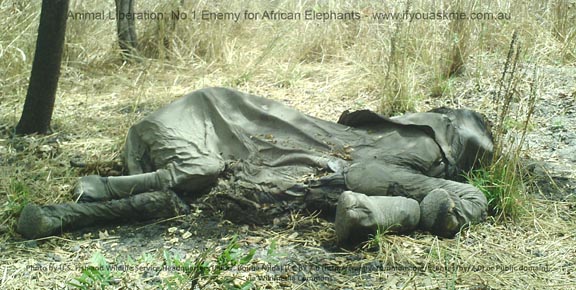
This is the future for elephants if we allow the animal liberation movement to continue to interfere in working conservation programs.
If you ask me, the biggest threat to African elephants is not poaching, habitat loss, animal human conflict or hunting; it is the animal liberation movement that poses the greatest threat to elephants. Before you scoff and say that is impossible, or ridiculous, please read on and learn why I make the assertion that the animal liberation movement is indeed, and without doubt, the number 1 enemy of the African elephant.
The reason that animal liberation is the number 1 enemy, of the African elephant, is simply because animal liberationists put their own self-interest and self-gratification before the genuine welfare of elephants. They refuse to understand that, in some African nations, elephant populations are in excess of the carrying capacity of the land. In addition, they oppose any conservation strategy that involves man taking charge of elephant populations and bringing the numbers down to within that carrying capacity. Further, they are totally ignorant that the most effective, and in most cases the only, means of controlling elephant populations involves either culling or regulated sport hunting. Animal liberationists are opposed to all human interaction with animal populations and so they automatically, and without any thought for reality, oppose any conservation measures that include population control.
This opposition to conservation programs, that include culling and hunting, is not based upon any sound scientific thought or logical process. This opposition is simply based upon the animal liberations’ ill-informed and short-sighted emotions and feelings. It is simply so that they, the animal liberationists, can con themselves into believing that they are some sort of ‘special friend’ to the animals. Indeed, animal liberationists foolishly, and ignorantly, believe themselves to be the only friends of wildlife.
They also oppose population control measures because they have been seduced by the falsehood of anthropomorphism and the belief that all animals think and feel like humans do. Further, they oppose working conservation tools because they are totally ignorant about the ‘mechanics’ of the environment, the importance of biodiversity or, to put it another way, how ‘Mother Nature’ operates and the checks and balances that ‘she’ employs. Animal liberationists have been brain-washed by the ‘Disney’ version of nature; a version that is all about making money at the expense of the truth.
Animal liberationists have adopted these dangerous views while they turn a blind eye to the true workings of nature, the inherent character of Africa’s wild places and the impoverished and burgeoning human population of Africa. They refuse to accept that, despite these serious problems, many African nations have been doing a good job of saving their wildlife, including elephants. To placate their own fragile and poorly formed emotions, about wildlife, animal liberationists work towards destroying conservation programs that have been successful in saving, and even increasing, many populations of Africa’s elephants.
Through their inability to recognise, or appreciate, alternative views, animal liberationists embrace false beliefs and doomed strategies. For example, they hold Kenya up as a model of how African nations should treat their wildlife and they do this simply because Kenya banned hunting in 1977 and, as this fits with their erroneous agenda, they automatically praise this move. However, what should be realised is that the original ban was meant to be a temporary ban, that is until the animal liberationists interfered. Through this interference the ban was made permanent and, as a result, modern-day Kenya has one of the worst records for conservation in all of Africa. Kenya, while playing by the animal liberationists play-book, has lost nearly 70% of her elephants and a similar percentage of other wildlife and this is while many other African nations, who have till now rejected the animal liberation views, have seen large increases in their elephant and wildlife numbers.
In putting their own feelings first, animal liberationists risk serious damage to elephant populations, elephant habitat and to the other animals that share that habitat. Animal liberation, with it’s goal of removing all human interference in the affairs of animals, foolishly rejects all working conservation programs that involve any form of game management. These people seem to think that we only have to leave wildlife to their own devices and then the animal rights ‘fairy’ will wave it’s magic wand and everything will be OK. However, this approach can only end in one outcome and that is the catastrophic loss of a large part of the elephant population, destruction of elephant habitat and severe damage to all the other animals, birds and plants, that depend on that habitat. Instead of saving elephants, animal liberationists are accelerating their descent, towards extinction.
In pre-colonial Africa, mother nature had a very good handle on the balance of nature and elephant populations were fairly safe and stable. Then along came modern man, first the Muslims with their slave and ivory trade. Then came the Europeans who, at first, thought that the wildlife of Africa was inexhaustible. However, even the big game hunters of yesterday soon came to realise that control and management, of the wildlife and hunting, was essential if the game was to survive mankind. Indeed, it was the Colonial governments and the hunters, of the early 1900’s, who pioneered African wildlife conservation long before the term ‘animal liberation’ was even invented. As a result, In the early years of the 20th century, most African countries put game conservation measures, and controls on hunting, in place. This worked well and the game populations survived and even increased under these new rules.
Then along came independence, and much of the old system was retained although often abused by corrupt officials. Nevertheless, many African nations still retained excellent populations of game and, especially, elephants because they continued, or updated, the colonial systems of game management. The simple, and unavoidable, fact is that when wildlife has monetary value, which then benefits the local people, then those people will work to save those animals. In Africa, when wildlife has no value then there is no incentive to save it; especially when those animals threaten crops and even people’s lives.
You have to realise that just a couple of elephants can destroy a rural African family’s crops for an entire year. Faced with this threat to their food supply, their livelihood and their physical safety (elephants can be extremely dangerous) who can blame a rural African for killing an elephant in spite of conservation laws? However, if that same elephant can be taken by a sport hunter, who pays huge sums of money which is far in excess of what the rural family could ever earn from crops and livestock, then those people will accept, and even protect, that elephant. The animal liberationists may not like this situation but what they like, or dislike, is immaterial to the end goal of saving Africa’s elephants and other wildlife.
The big profits, for poaching ivory, are made in Asia, at the end of the smuggling routes, and not in the African bush. The poachers, themselves, are only paid a very small amount of the profits. In comparison, the income that rural Africans can earn, from sport hunting, is far greater than they could ever earn working with the ivory poaching syndicates.This creates a strong incentive to abstain from the poaching of elephants and, indeed, to protect ‘their’ elephants. Why kill elephants, and risk prison or being shot by anti-poaching teams, for a smaller amount of income? Far better to protect the elephants, turn in the poachers, work with the anti-poaching teams, sell off a handful of elephants when their numbers become excessive and earn a great deal more money. It isn’t hard to see that, in a system where elephants and wildlife in general have a monetary value, then the rural peoples will come to see the poachers as their enemies. In such a system, the poachers are, in effect, stealing from the local people and so will lose their support.
In pre-colonial Africa, it is estimated that there were around 10 million elephants. Today, depending upon which survey you read, there are between 400,000 and 600,000. Now, this may sound like a serious decline and, in purely numerical terms, it is. However, to simply talk about population numbers, without considering the size of the remaining habitat, is a serious mistake. Over the past 200 years, huge swathes of Africa were divided up by national borders, towns, roads, farms, factories and all of the other land use that goes with civilization. The end result is that the amount of land, that is available for the African elephant, is only a fraction of what it was before. Put into this context, it can be seen that the population of African elephants, today, is not as bleak as simply comparing numbers would imply.
What also needs to be realised is that some African nations have done a better job of conserving their elephants than others have done. As a result, some African nations have far too many elephants. Yes, I did say FAR TOO MANY ELEPHANTS! Countries such as Zimbabwe and Botswana are prime examples of this situation. It should also be noted that these countries, at least until recently, have always retained wildlife management programs that included culling and sport/trophy hunting as part of those programs. Unfortunately, both of these countries have recently succumbed to pressure from the international animal liberation movement and have curtailed much of their culling operations. The result is that their elephant populations, which are already way in excess of supportable populations, will continue to increase till a point is reached where a catastrophe will result.
The problem is that elephants are very destructive feeders that eat huge quantities of plant material. They will even destroy whole trees to get at the tasty morsels in the top branches. Elephants will tear apart entire baobab trees, which have been growing for hundreds of years, to get to the succulent portions. Now, when elephant populations are in balance, the loss of a few trees is not a problem and simply contributes to the cycle of nature. However, when an area contains too many elephants, the damage can be disastrous and irreparable.
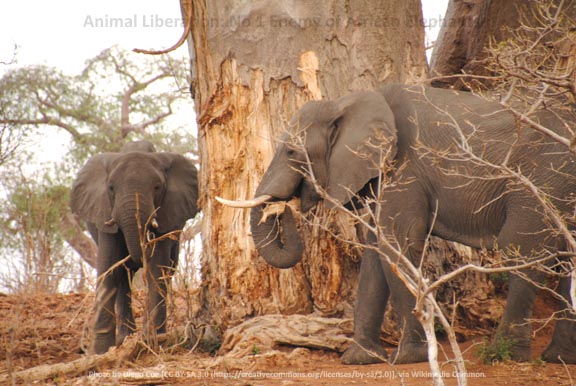
Two elephants feeding on the bark of a baobab. Baobabs are hundreds of years old but elephants can destroy them, completely, in a matter of weeks.
Too many elephants means that plants and trees will be destroyed at a rate that nature cannot replace. These plants and trees are also homes and food for other animals. These plants and trees also hold the vital topsoil in place. When an overpopulation of elephants overgrazes an area, not only do we see the elephants starve, but we see all of the other game starve, we see the loss of plants and trees and we see serious erosion of the topsoil. When the topsoil is lost, along with the seeds and nutrients that it contains, then the area cannot recover. The end result is mass starvation of elephants and other wildlife, total loss of habitat and the destruction of the biodiversity of that region. This is a serious, but avoidable, catastrophe.
When the animal liberationists try and stop African nations from managing their elephant herds then they are depriving those nations of the ONLY tools that work in keeping the elephant’s habitat intact. It is far better to shoot a sustainable percentage of the elephant population, and ensure the survival of the rest of the herds, than allow the uncontrolled explosion of elephant populations that will, without a doubt, destroy the habitat and cause the loss of far more elephants, and other animals, than would be shot.
This is why I said that the animal liberationists put their self-interest, and self-gratification, before the welfare of elephants. Because these people hate any form of management, but especially culling and hunting, they would condemn far more elephants to a cruel death, by starvation, than would ever fall to the hunter’s guns. No one is saying that the animal liberationists have to like culling or hunting, only that they should learn the truth about conservation and stop interfering in conservation programs that work.
African nations know more about managing their wildlife than animal liberationists in Europe, America, Asia or Oceania will ever know. It is time that the rest of the world supported working African conservation programs rather than attack them, denigrate them, and try and replace them with ill-conceived ideas that simply do not work; and all because a handful of animal liberationists don’t like practical wildlife management programs.
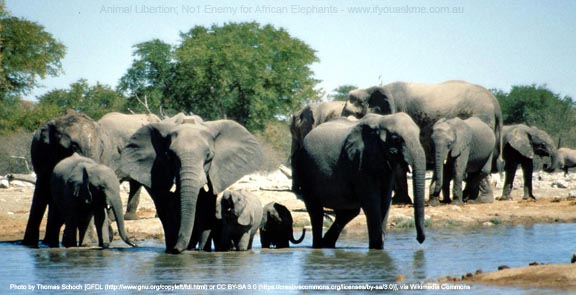
This is the scene we want to see long into the future; a herd of elephants, plenty of water and lots of foliage.
In the next part of this post, I will look at some of those ill-conceived, animal liberationist plans that they claim will work in place of culling and hunting. This will include such ideas as darting, capturing and relocating elephants as well as sterilization of wild elephants.
© Copyright 2017 Robert Pretty
You can read other posts on conservation and animal liberation on this website and here are a couple of links you may be interested in:
Some Truths About Trophy Hunting – Part 1.
Animal Liberation is NOT Conservation.

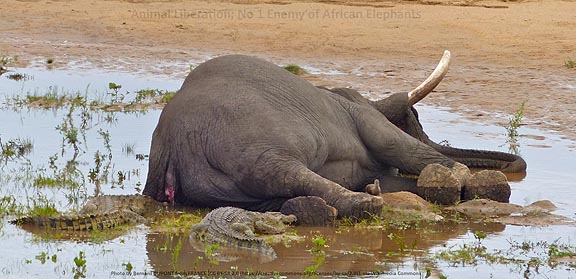
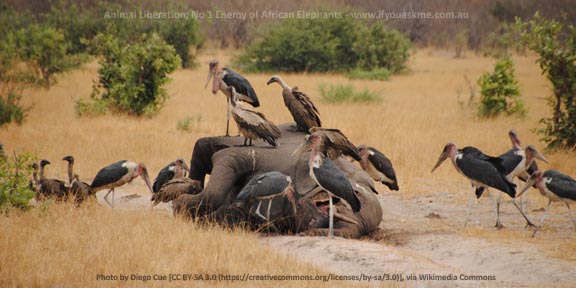
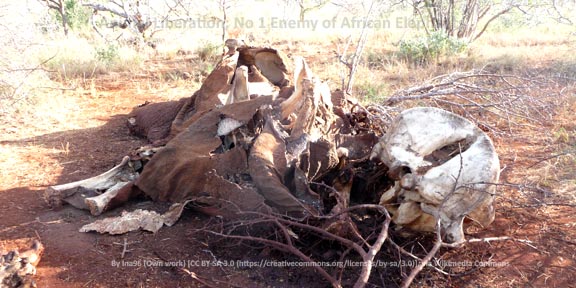
They don’t really care about animals, they’re just virtue signalling to they’re harpy friends about how much of an ally they are.
They should go to Africa and see how things are objectively.
I wish I could force choke them like Darth Vader can.
These people virtue signal, like yourself. You use pics of dead carcases to get your point accross. How is that different to the vegans or animal liberationists? You know they do that too?
The difference is that the animal liberationists and the vegans are motivated by trying to justify their own self-centred views. I am motivated by a genuine desire to do something constructive for African conservation and to stop the descent, towards catastrophe, that the animal liberationists have started by interfering with working conservation programs. I make no apology for the images I used because, if things are allowed to slide further into the twisted animal liberation philosophy, then those are the images of elephants we will have to get used to.